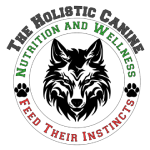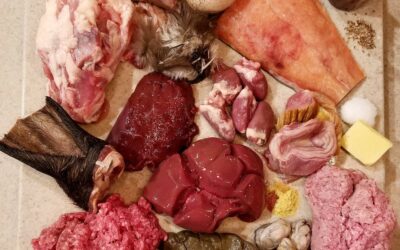The Importance of Cartilage in the Canine (and Feline) Diet
Cartilage is made up of highly specialized cells and a matrix of proteins. It is more matrix than cells because cartilage does not contain blood vessels to receive oxygen which creates a low-oxygen tissue that is not an ideal environment for cells. The matrix of cartilage is made up of proteins known as collagen and proteoglycans as well as other minor proteins. The wealth of value found in feeding cartilage to pets is in the matrix where we find the collagen, hyaluronic acid, and chondroitin. Because collagen is the most abundant protein in the body, it is vitally important that your pet receives an abundance of collagen from cartilage in their daily meals. As our pets age, their collagen production decreases in the same way as ours. This can lead to an increased risk for tendon and ligament injury and damage, joint injury and destruction, muscle soreness after exercise, and even muscle atrophy. Hyaluronic acid acts as a lubricant and a cushion for the joints and tissues assisting in preventing injury. Couple these with chondroitin, a chemical found primarily within joint cartilage that creates elasticity and the ability to retain water, and you have a cocktail of nutrients that, according to numerous studies, are twice as effective as using glucosamine supplements for joint health. If this is not beneficial enough, cartilage also contains micronutrients that include manganese, copper, and even some vitamin C. Thus it is vital to feed your pet all types of cartilage-rich raw meaty bones (RMB) such as joints, rib cages, and vertebrae as well as cartilage structures such as trachea, ears, and bronchial tubes.
This begs the question, what or how is the best way to feed cartilage to your pet? Since many pet parents follow the popular 80/10/10 meal-formulation guide [80/10/10 is a ratio formula used to create raw meals that translates into 80% muscle meat, 10% secreting organs (5% liver + 5% other), and 10% bone], I am often asked, which category would non-bone cartilage such as trachea or ears fall into; bone or meat? It certainly seems to be a reasonable question, but is applicable only if a pet parent is following a ratio too strictly. In all honesty, it is an irrelevant and futile question in that in the attempt to categorize every tissue and body part ingredient into the 80/10/10 formula, pet parents tend to lose sight of an important fact . All parts of a prey animal’s carcass is simply a part of one WHOLE. Now don’t get me wrong, the 80/10/10 formula is a great guide to reining-in and limiting ingredient amounts to avoid an improperly “balanced” meal. So, let’s consider this more deeply by more closely examining bone and meat.
Cartilage is an integral part of all joints and has a close resemblance to bone in that they both contain a collagen protein matrix. Bone, however, also contains specialized cells and minerals that create the hard outer tissue, soft spongy marrow, the periosteum and endosteum as well as containing a network of nerves and blood vessels. Bone also functions to create blood cells within the bone marrow. Bone is the best and most vital source of macro-minerals in the diet, not to mention also being a great source of trace minerals and vitamin E (which is stored within the marrow). Muscle meat, on the other hand, is made up of excitable cells constituting skeletal, cardiac, and visceral muscle tissues. Muscle cell fibers contain a mere 1% to up to 10% collagen protein which is much lower and very different from cartilage. Muscle is mostly protein filaments known as actin and myosin (which allow for movement) with varying percentages of fat along with facia, nerves, blood vessels, blood, and more. Muscle is a major source of multiple vitamins and minerals that contributes a great deal to nutrient-requirement fulfillment in meals.
Living beings are not merely made up of muscle, organs, and bones as is inferred by the 80/10/10 ratio. Animals, like us, are comprised of four types of tissues: epithelial tissue, connective tissue, muscle tissue, and nervous tissue as well as fluids. Epithelial tissue includes the lining of the intestines (hollow organs) and surface skin. Connective tissue includes bone, tendons, ligaments, cartilage, and fat. Muscle tissue includes skeletal muscles, cardiac muscle, and internal organ muscle (any organ that produces movement). Nervous tissue includes the brain, spinal cord, and nerves. You may note that feeding only muscle, bone, and secreting organs does not create a proper “whole” and leaves out many body structures. Thus following a ratio is unrealistic and can, overtime, create deficiencies and/or toxicities if followed too strictly. This is why it is imperative to feed a species-appropriate diet (following what I call a Frankenprey model) that contains ALL parts of the whole. Whole prey would be ideal, but is not within the grasp of many DIY of raw feeders. Thus for those pet parents who cannot source whole prey, the goal should be to create the likeness or resemblance of whole prey on the plate or in the bowl.
How then do we feed cartilage? ANSWER: As part of the WHOLE. It is not bone and it is not meat. However, cartilage IS connective tissue which is in the same category as bone. Cartilage is easiest to feed as part of raw meaty bones in the daily diet. Adding in cartilage structures such as trachea and ears does not require a category as these types of structures should be fed in smaller amounts to be sure to not decrease the muscle protein being fed. Keep in mind that raw meaty bones contain bone, muscle, and cartilage! Focus on the RMBs in the diet and use the remaining vital ingredients (boneless meat, muscle organs, and secreting organs) to “fill in the blanks.” In fact, if you want to create a truly complete raw meal, feeding the more yucky parts is essential. By this I mean large vessel structures, connective tubes, glands, hide, ears, hoofs, feet with nails, and all the stuff I see most pet parents trimming off of their meal ingredients! Leave it on. Add in blood and myoglobin as well for a truly complete and nutritious meal. Raw feeding isn’t for the squeamish. We are feeding carnivores, after all. ![]()



